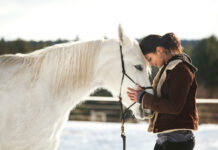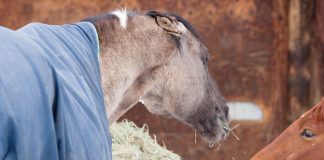
One thing that never changes about horsemanship is that most riders search endlessly for ways to improve the performance of their mounts. Not quite satisfied with what we’re getting out of our horses, we’ll try this technique or that approach in the quest for great results. While it’s good to strive to improve our horses, there’s a fine line between having reasonable training expectations and pushing too hard and expecting too much.
Much of what I speak of is bonafide animal behavior doctrine, but I’ve learned the truth of it through my own experiences as a trainer. In all honesty, some of the most harmonious times I’ve had with horses actually occurred before I acquired a “formal” riding education.
I was 10 when I was given a horse of my own in the form of a 5-year-old, untrained Welsh Pony. The school of hard knocks taught me balance, and I taught Amigo what he needed to know to be controllable: to walk, trot, gallop, turn or stop in response to my cues. That was all we needed to be in complete harmony together—absolutely nothing more. My purpose in owning a horse was to feel a part of what he was: to feel the wind in my face as we galloped down the trail, to sit in the grass and watch him eat and to have him follow me everywhere of his own free will. I enjoyed him and the horse that followed, a Thoroughbred-Appaloosa mare named Canela, with the freedom of spirit that came from accepting them exactly as they were and appreciating what came naturally from them in return. I imposed minimal stresses on them because standards of performance were the furthest things from my mind, and what resulted from this simplicity was a unity where horse and rider were willing partners.
Changing Goals
My connection with horses remained my driving force, and as a young adult I elected to pursue formal training to develop a career with horses. By this time I already had proper riding lessons under my belt, but now my academic pursuits were grooming me to be a professional trainer. I was learning the fundamentals of training horses and riders for the show ring, and the emphasis of my relationship with my own horse started to change. I realized I had to start building my reputation as a trainer in the show-ring, and my horse had to help me achieve this end. It started to be increasingly important to me to show frequently and place well. It became harder to appreciate my horse for her unique qualities when we were being judged by someone new every weekend and our performances were being measured against ideals.
A particular philosophy I encountered early on seemed very effective at the time, but has proved to be flawed over the long term. You’ve probably heard some version of the philosophy that the road to success is to make the horse more concerned about disobeying you than he is about the things in his environment that worry him. In other words, make the cost of misbehavior high enough to keep the horse in line. Dominating the horse in this fashion may net quick results, but dominating through force rather than by gently cultivating willing performance can ultimately lead to a sour attitude. It’s true that dominance of one horse over another is a natural part of the herd dynamic that all horses understand, and riders should expect to be the dominant member of the horse and rider team. But be aware that being assertive and being aggressive are two different things. Appropriate corrections serve to remind your horse that you’re the leader, while the correction that’s overdone can make your horse fearful and possibly resentful of you. Remember that a patient approach and consistent techniques are the long-term partnership builders.
Working With the Horse’s Nature
Effective riders understand and learn to work around, rather than battle against, the natural tendencies of their horses. It’s important to learn to accept the inherent behavior patterns that define this species because they are relatively consistent and unchanging. They are the limiting factors that riders must work within. Respecting our horses as partners means never trying to overpower them and force them into performing like wind-up toys. It means recognizing that the burden of effective communication between horse and rider ultimately belongs to the rider. Getting more adamant usually isn’t the solution if a horse responds inappropriately to a cue. Instead, recognize that the message is probably not understood. Learn to enjoy and delight in the process of developing the type of relationship with a horse where meaningful communication and true understanding build a partnership that is its own reward.
There is an essential element of horse behavior that can help us to be effective with them. First and foremost, horses are prey animals. Their senses are quickly aroused, and they react instantaneously to what they sense in ways that may seem extreme to us. When they sense something threatening, their inclination is to panic, bolt and run. If we don’t make allowances for this species-specific behavior in our training approach, we’re doomed to fail. We can help them learn to react to their fears in a “safer” way, but we cannot train their fear out of them. Their sensory modalities are different than ours, and we may not have the physiologic ability to perceive much of what they react to. However, there is usually a legitimate, underlying reason for the flight reaction, whether or not we’re actually aware of it.
While it’s true that there are behavioral patterns that prevail in most horses, it’s also important to recognize that each horse is an individual with a unique personality. Instead of struggling to make horses fit into a mold, accept and embrace each horse’s individuality as a mystery you have the privilege of trying to understand. Riders have a role much like that of a school teacher in that we must keep our pupils feeling positive about the training process by allowing them room to express their uniqueness. You’ve probably watched a jumper or two that likes to throw in a little buck stride here and there on course that seems to say, “I’m feeling good and having a great time!” Others just go quietly and uneventfully about the same business. They’re all doing the same work, yet each horse’s individuality shines through. If a rider is attuned to her horse, she’ll know the difference between ordinary behavior stemming from her mount’s unique personality quirks and the tense, rigid, sullen behavior of an unhappy horse. This is a very important distinction to make, because the former is acceptable, while the latter should alert the rider that it’s time to slow down and get the horse back on the team.

Even when we truly love and cherish our horses, it’s very easy to succumb to the ever-present pressure to perform. Who out there doesn’t want to be the one with the glorious horse that can do it all? What show rider doesn’t have her sights set on the blue ribbon? The problem is that sometimes the desire to excel makes riders try to rush things that really take time to develop.
Losing Focus
Winning was everything to one longtime campaigner I knew several years ago. He tried out new horses as easily as he changed clothes each show season. If the horse didn’t win, down the road he went, and another prospect was purchased to take his place. He talked endlessly about the latest training gadgets, and he was reputed to employ a pharmacological advantage over the competition from time to time. He embraced techniques that made his horses tired or sore on the day of the show to gain their compliance in the ring. When he collected a blue ribbon or trophy to add to the abundant collection on his walls, his horsemanship was validated. When he lost, he was miserable, and the horse could expect a renewed burst of training wizardry. The tragedy of this situation was that the joy that should have been part of the horse-rider relationship was conspicuously absent here. Everything of value to this horseman was won or lost on a perfect stranger’s call.
It’s easy to think that winning in our disciplines is a valid test of the training we’re doing. But does the show ring really respect the individual differences between horses, or does it tend to expect homogeneity from its diverse population? Do you want your horse to be your partner or a cookie-cutter model reluctantly enslaved beneath you?
Instead of aiming to win, riders might make better use of the show ring by using it as an opportunity to evaluate their own progress against that of prior shows. Instead of looking at the placing in the class, it might be more objective to look at the trend in the horse and rider scores over time to assess one’s own training progress. Winning should not be the objective—team building should!
The aim of riding should always be to bring out the best in our horses. Whatever happens to be the performance event we enjoy, we can find our pleasure in the feeling of unity and harmony that develops over time as we develop our horse’s willing cooperation in our performance endeavors. It’s a long, often harder road that requires patience and humility, but the rewards we garner along the way make it well worth the effort. Learning to read and understand our horses well is an investment that pays some very satisfying dividends!






Excellent! I will keep the subject of this artice on my mind.
I love reading the training articles. Keep them coming!
Good article!! I will have to reread this many times.
Absolutely, positively agree with training article. Great perspective.
wow, so true! thank you for this article!
This is the best article and is everything I have tried telling my family and friends! Thank you horsechannel!
Great advice.
Well written article.
i love this article! thank you!
well done I prefer to know my horse is my trusted partner ready to get me out of any trouble we may find ourselves in than a push button but it would also be nice for him to listen to me as much as I listen to him
cool
Good article